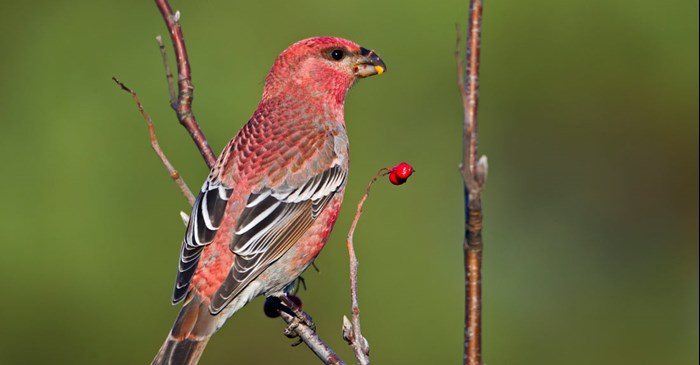The Pine Grosbeak is a type of finch with a gray body and a wash of pinkish-red feathers on his head, back and breast. (Females sport feathers of burnished gold.)
Depending on where they live, they vary in size and the amount and depth of redness in their feathers. Pine Grosbeaks in California and British Columbia are smaller than those found in the more challenging climates in the Yukon and Alaska.
Pine Grosbeak habitat
In North America, the Pine Grosbeak is largely a Canadian bird, but they also live year-round in scattered pockets throughout the Western U.S. — usually in cooler mountain climates where plenty of evergreen grow. (Pine Grosbeaks are also found in East Asia and Scandinavia.) They can also be found year-round in northern parts of Minnesota, Michigan, New York, New Hampshire, Vermont and Maine.
An irruption of Pine Grosbeaks
During the winter, some places may experience an irruption of Pine Grosbeaks. That is, they might migrate south, but that's entirely driven by the availability of food. Out west, that may mean simply heading out to a lower elevation. Wherever they end up they form winter flocks of 5-15 birds.
How to find a Pine Grosbeak
In the summer, if you catch their song, stop and look around. Birders find the Pine Grosbeak is relatively easy to find and view. They’re often described as “plump,” “sluggish,” even tame. They’ll allow humans to get close before taking off, making it easy to get a good look.
Diet of a Pine Grosbeak
Unlike many birds, their diet is largely plant based year round. You’ll find them foraging in trees and on the ground for buds, seeds and fruit. However, in the summer, they do catch insects and spiders to eat and to feed their nestlings.
If you get word of an irruption of Pine Grosbeaks in your area, sunflower seeds are a surefire way to draw them in to your feeder. Lyric Supreme Mix offers a whole seed blend featuring black oil sunflower seeds and other bird favorites.
